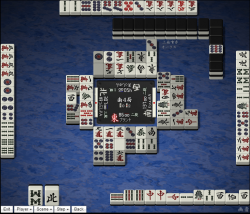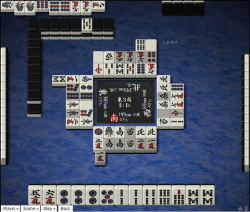Tanki
| Kanji | 単騎 |
|---|---|
| English | Pair wait |
| Fu | 2 fu |
| Tile types waiting | 1 sided wait |
| Tiles available | 3 tiles |
| Pattern example |
|
| Tenhou.net example |
Tanki 「単騎」 is one of the basic wait patterns. While most tenpai hands wait to complete the fourth tile group, a tanki wait serves to complete the hand's pair. Thus, it may be referred to as a "pair wait" in English. Unlike the other basic patterns, there are a few types of pair waits to consider.
Pattern
The wait pattern involves waiting for a single tile, waiting to complete a pair, with the rest of the hand complete.
Hadaka tanki

Hadaka tanki 「裸単騎」 is a tanki wait formed after a hand calls for 4 different tile groups. After the 4th call, the hand is left with only one tile in its closed section, with a tanki wait on that tile. A suukantsu tenpai always has a hadaka tanki wait.
A hadaka tanki does not have any special properties as a wait, but having only 1 tile in hand does impact things:
- There's almost no room for defense. The worst possible case for hadaka tanki is when the tile in hand and tile drawn are both tiles that a player can ron.
- Your opponents know you are in tenpai for a tanki wait, so tactics like suji do not work. However, if all 4 copies of a tile are visible, it is safe.
Jigoku
Jigoku 「地獄」 ("hell wait") is a tanki wait where two of the three tiles are visibly unavailable (e.g. discarded, used as dora indicators). Thus, only one tile is left, making a win particularly unlikely. The final tile could be in another players hand or the dead wall, making a win totally impossible.
Nakabukure
Nakabukure 「中膨れ」 is a tanki wait where the hand has: a sequence, a duplicate tile in the middle of the sequence, and waits on the duplicate tile to complete a pair. Since two of the tiles are already in hand, this wait has one less available tile than a regular tanki.
While not good as a tenpai wait, this shape is strong for improving the hand before tenpai. In the above example, drawing any of 2s-5s or 3s-6s results in a ryanmen wait (a normal 4s would only create a ryanmen with 3s-6s).
Nobetan
A nobetan is a two-sided tanki wait. The hand waits to complete a pair, but two types of tiles are eligible to complete the pair, because the to-be-paired tile is next to a sequence. Here, if a 3p is drawn, you are left with a 3p pair and 456p sequence. If a 6p is drawn, you are left with a 345p sequence and 6p pair. A nobetan is aligned with suji intervals.
Sanmen nobetan
Sanmen nobetan is a three-sided tanki wait. It works like a nobetan, but attached to two sequences instead of one sequence.
Value
By default, the tanki wait counts for 2 fu.
- If the pair happens to consist of yakuhai tiles, then an additional 2 fu is added for said pair.
- If the pair is both the round wind and your seat wind, it may - depending on the ruleset - adds 4 fu instead of the usual 2 fu for yakuhai.
Chiitoitsu hands always have a total of 25 fu, regardless of their wait, types of pairs, or winning type.
Strategy

A one-sided tanki is considered a "bad wait". It can only wait for a maximum of 3 tiles (of one type), making it the least accepting of all the basic waits.
However, the main advantage of tanki is that it you can wait for any type tile, so long as there is at least one copy of the tile remaining. This makes it strong when wanting to win from another player's discard. It is immune to suji and (to some extent) kabe, so it can be used to set suji traps. A tanki wait on a once-discard honor tile is strong, as players may believe said tiles to be safe. A hell wait on an honor tile, while unlikely to actually win, is particularly good if you want to win from another player.
Chiitoitsu hands always have a tanki wait.
A nobetan is of a similar strength to a ryanmen wait - it has good acceptance (maximum of 6 tiles of two types), but other players can use suji against it. However, nobetan cannot be used for pinfu.
Upgrades
Closed, non-chiitoitsu hands with a tanki wait tend to have a large amount of wait upgrades:
- Draw a tile adjacent to a sequence to form a 2-sided nobetan.
- Draw a tile on either end of a sequence to form a 2-sided aryanmen.
- Draw a tile adjacent to a triplet to form a 3-sided ryantan or 2-sided pentan.
- Draw a tile two tiles away from a triplet to form a 2-sided kantan.
- Draw an honor tile or a tile affected by suji/kabe to have a trickier wait.
Due to the sheer amount of upgrades, it can be worth delaying riichi with a tanki wait.
Example:
In total, there are 13 tiles of tile (45 tiles total) that create a 2-sided wait. That does not include honor tiles that can be drawn to make the tanki wait stronger. However, with this many upgrades, beware of furiten.
Related Complex Waits
These complex waits are related to tanki waits.
Aryanmen
A ryanmen wait that is adjacent to the hand's pair. When winning with the 6p, this hand can be interpreted as either a "66 + 78" tenpai (a ryanmen wait) or a "6 + 678" tenpai (a tanki wait). The interpretation that would result in the most final points is used.
When winning with 9p, the other side of the ryanmen, the hand can only be interpreted as having a ryanmen wait.
Ryantan, Kantan, & Pentan
These three wait patterns can all be described as "a triplet with one adjacent tile attached". They are effectively combinations of tanki and another type of basic wait.
Ryantan (Ryanmen + Tanki) - Triplet with a tile that is numerically adjacent, and neither the triplet or the extra tile are a terminal tile. This can be interpreted as "33 + 34" or "333 + 5", thus waiting on 3 types of tiles (2 or 5 or 4). This wait is worth fu only if it wins off the lone tile (in this case, the 4).
Kantan (Kanchan + Tanki) - Triplet with a tile that is numerically 2 away. This can be interpreted as "33 + 35" or "333 + 5", thus waiting on 2 types of tiles (4 or 5).
Pentan (Penchan + Tanki) - Triplet with a tile that is numerically adjacent, and at least one tile is a terminal. This can be interpreted as "11 + 12" or "111 + 2", thus waiting on 2 types of tiles (2 or 3).
External links
| ||||||||||||||||||||||
